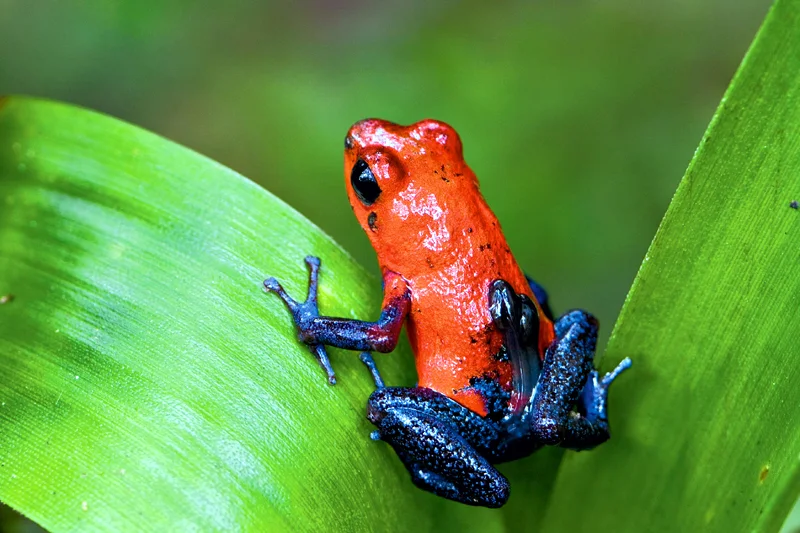![[feature] Amazing animal moms](https://blogger.googleusercontent.com/img/b/R29vZ2xl/AVvXsEiM2Umj25V8JzmBJrDb6u-jswKPOJL2qYwVT9BbzMUws6wJFGPDmWzcq9YuUtfgpspSrOoxJmGZ9SomneO5W0DiWp478a08luUiFmMHIkDslzkarHdM5oWPVkdcTPOSlPdfWqIlo_P0ztQF/s1600-rw/dearjulius.com.jpg)
By Rachel Buchholz, National Geographic
Jumping in
 |
| © Photograph by Konrad Wothe / Minden Pictures / National Geographic Image Collection A strawberry poison dart frog carries tadpoles on her back in Costa Rica. She'll eventually place them in separate plants for good reason: Tadpoles are cannibalistic. Talk about sibling rivalry! |
It might seem strange to care about a tadpole, but strawberry poison dart frog moms certainly care about theirs. After her eggs hatch, the mother carries up to five tadpoles on her back to bromeliad plants in Central American rainforests. She deposits each tadpole into the water-filled center of its own bromeliad, where the leaves have grown into a rosette, similar to the shape of the top of a pineapple. Every day for nearly two months, she returns to the plants to care for her babies and lays up to five unfertilized eggs for each tadpole to chow down on. This frog mom doesn’t really care that her babies don’t look like her—yet. She’s still going to care for them no matter what.
Spot training
 |
| © Photograph by Albie Venter / Shutterstock Cheetah moms will encourage their cubs to practice their hunting skills by play fighting. |
As the world’s fastest land mammal, cheetahs are often considered to be the perfect predator. But they certainly aren’t born ready for that role. In fact, newborn cheetahs have no survival instincts, which leaves them pretty helpless. Luckily, Mom is on the case. It’s up to her to teach them the skills they need in order to grow up strong, fast, and successful. For two years, they’ll watch her closely. They’ll learn how to use their spotted coats to blend in with the African grasslands. They’ll observe how to burst onto their prey and bring it down quickly. When it comes to surviving and thriving, their mother is the best teacher they could have.
Don’t mess with mom
 |
| © Photograph by Mark MacEwen / Nature Picture Library Both crocodile and caiman moms (like the broad-snouted caiman shown here in Argentina) carry babies in their mouths from the nest to the water. |
Most people wouldn’t consider giving a crocodile a Mother of the Year award. Yet despite their fierce reputations—a 20-foot Nile croc will take down everything from a zebra to a human—these reptiles are actually devoted mothers. Most reptiles lay their eggs and then disappear forever. But a crocodile mom keeps a close watch on her nest after she’s buried her eggs, guarding it for three months from potential predators. Her babies will make high-pitched squeals when they’re about to hatch, and Mom will quickly dig up the eggs. Once hatched, the babies ride in Mom’s mouth as she carries them to the water, where they’ll live under her protection for about two years. Seems like when it comes to crocodiles, an outer toughness hides an inner gentleness.
All in the family
 |
| © Photograph by 1001slide / iStock Mother elephants use their trunks to help their babies move around obstacles and pull them out of holes. |
Every child needs a role model to look up to and learn from. Luckily for baby African elephants, they’re surrounded by them! Related females help raise all the calves in a herd and set examples through their behavior. When a mom makes a tool, such as a flyswatter out of a leafy branch, a young elephant will make one too. If a female uses her trunk to forage for food like berries, leaves, and grasses, the baby will do the same to learn what’s edible. Young elephants even learn parenting skills by watching another mom—when she gently wraps her trunk around her newborn calf and lifts it to its feet, for example. In the elephant world, there’s no shortage of strong female role models.
Whale tale
 |
| © Photograph by Fabrice Guérin A humpback mom’s yogurt-like milk is almost 50 percent fat. No wonder babies grow up to 30 feet during their first year. |
Humpback whales are solitary creatures. Unlike dolphins or orcas that travel in pods, humpbacks prefer to keep to themselves and swim solo. Except, that is, moms and babies, who share an incredible bond. After bringing the baby to the water’s surface for its first breath, the humpback whale mother stays with her calf for a year, never straying more than a body length away. She’ll patiently watch the baby unsuccessfully attempt to breach or flap its tail, then demonstrate proper humpback technique. Moms and babies will also touch each other’s flippers in what many believe is a gesture of affection. The humpback mother’s constant support means that one day her baby will be able to dive headfirst into life on its own.
























